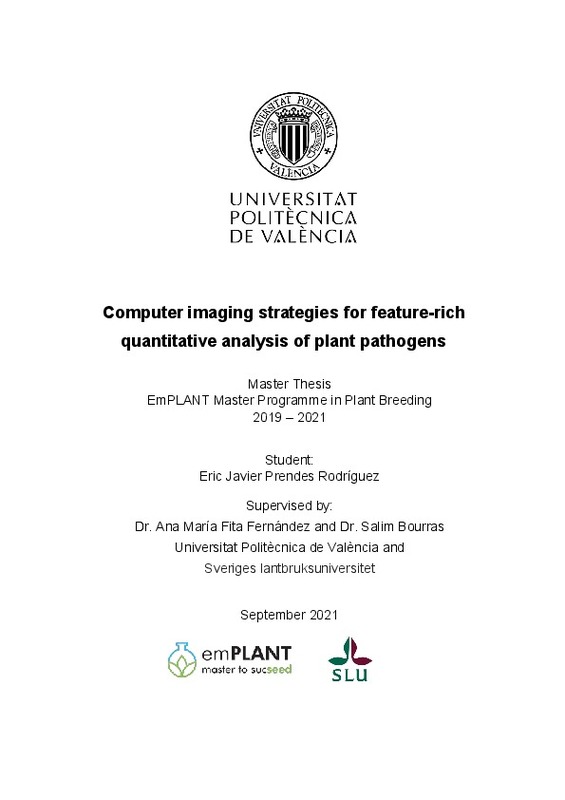JavaScript is disabled for your browser. Some features of this site may not work without it.
Buscar en RiuNet
Listar
Mi cuenta
Estadísticas
Ayuda RiuNet
Admin. UPV
Computer imaging strategies for feature-rich quantitative analysis of plant pathogens
Mostrar el registro sencillo del ítem
Ficheros en el ítem
| dc.contributor.advisor | Fita Fernández, Ana María
|
es_ES |
| dc.contributor.advisor | Bourras, Salim
|
es_ES |
| dc.contributor.author | Prendes Rodríguez, Eric Javier
|
es_ES |
| dc.date.accessioned | 2021-11-14T14:12:42Z | |
| dc.date.available | 2021-11-14T14:12:42Z | |
| dc.date.created | 2021-09-22 | |
| dc.date.issued | 2021-11-14 | es_ES |
| dc.identifier.uri | http://hdl.handle.net/10251/177057 | |
| dc.description.abstract | [ES] La detección fenotípica precisa y la cuantificación de fitopatógenos es un desafío importante en las ciencias vegetales. Gracias al rápido desarrollo de las tecnologías digitales y, más específicamente, a las técnicas de imágenes por computadora, están surgiendo métodos nuevos y precisos para abordar este desafío con aplicaciones tanto en organismos modelo como en cultivos agrícolas. Esto constituye un recurso muy valioso para los investigadores y para los mejoradores, que a menudo deben depender del fenotipado manual y el puntuaje visual, técnicas las cuales consumen mucho tiempo. Actualmente existen múltiples herramientas que se pueden utilizar para este propósito, dos de ellas son ImageJ y PlantCV, las cuales se han convertido en paquetes de software de grado científico bien reconocidos. El primero es posiblemente el software de análisis de imágenes más utilizado en las ciencias biológicas, y el segundo es un conjunto de herramientas de procesamiento de imágenes derivadas de OpenCV que es más reciente, pero con muchas potencialidades para el análisis cuantitativo y el fenotipado digital en plantas. A pesar de la disponibilidad de estas herramientas como software de código abierto, su uso e implementación está restringido principalmente por el desafío que supone obtener datos que sean al mismo tiempo intuitivos y biológicamente significativos para inferir resultados útiles y correctos. En este trabajo, presentamos varios flujos de trabajo y metodologías para la extracción y análisis de datos biológicos basados en imágenes de dos patógenos fúngicos, Neonectria ditissima, un patógeno de árboles, y Blumeria graminis f.sp. tritici, el agente causal de la enfermedad del mildiú polvoriento del trigo. Este trabajo se basa en dos conjuntos de datos de entrenamiento generados a partir de ensayos in vitro e in planta, y usando tanto ImageJ como PlantCV. Las metodologías propuestas se evalúan técnicamente para su usabilidad en la extracción de información biológica rica en características, y los datos generados se evalúan para determinar su idoneidad para análisis cuantitativos que van desde la dinámica básica del crecimiento de hongos hasta el mapeo de QTL complejos. | es_ES |
| dc.description.abstract | [EN] Accurate phenotypic detection, and quantification of plant pathogens is an important challenge in plant sciences. Thanks to the rapid development of scalable digital technologies, and more specifically computer imaging, new and precise methods are emerging to tackle this challenge with application both in model organisms as well as agricultural crops. This constitutes an asset for researchers and for breeders, who often must rely on time‐consuming manual phenotyping or scoring by eye. Currently there are multiple tools that can be used for this purpose, two of them being ImageJ and PlantCV, both of which have become well recognized, scientific-grade software packages. The first, is possibly the most used image analysis software in biological sciences, and the latter is a more recent yet very powerful OpenCV-derived image processing toolkit for plant phenotyping analysis. Despite the availability of these tools as open source software, their use and deployment is mainly restricted by the challenge of obtaining data that is at the same time insightful, and biologically meaningful to infer useful and correct results. In this work, we present several pipelines and methodologies for image-based biological data extraction and analysis in two fungal pathogens, Neonectria ditissima, a tree pathogen, and Blumeria graminis f. sp. tritici, the causal agent of the wheat powdery mildew disease. This work relies on two training datasets generated from in vitro and in planta assays, and applied to both ImageJ and PlantCV. These approaches are here technically assessed for their usability in extracting feature-rich biological information, and the generated data is evaluated for its suitability for quantitative analyses ranging from basic fungal growth dynamics to complex QTL mapping | es_ES |
| dc.format.extent | 41 | es_ES |
| dc.language | Inglés | es_ES |
| dc.publisher | Universitat Politècnica de València | es_ES |
| dc.rights | Reserva de todos los derechos | es_ES |
| dc.subject | Locus del rasgo cuantitativo | es_ES |
| dc.subject | Fenotipado masivo | es_ES |
| dc.subject | Análisis de imagen | es_ES |
| dc.subject | Image analysis | es_ES |
| dc.subject | High-throughput phenotyping | es_ES |
| dc.subject | Phenotyping analysis | es_ES |
| dc.subject | Quantitative trait locus (QTL) | es_ES |
| dc.subject | QTL mapping | es_ES |
| dc.subject.classification | GENETICA | es_ES |
| dc.subject.other | Máster Universitario Erasmus Mundus en Mejora Genética Vegetal / Erasmus Mundus Master Programme in Plant Breeding - emPLANT-Màster Universitari Erasmus Mundus en Millora Genètica Vegetal / Erasmus Mundus Master Programme in Plant Breeding - emPLANT | es_ES |
| dc.title | Computer imaging strategies for feature-rich quantitative analysis of plant pathogens | es_ES |
| dc.title.alternative | Estrategias de imagen computarizada para el análisis cuantitativo rico en características de patógenos vegetales | es_ES |
| dc.type | Tesis de máster | es_ES |
| dc.rights.accessRights | Abierto | es_ES |
| dc.contributor.affiliation | Universitat Politècnica de València. Departamento de Biotecnología - Departament de Biotecnologia | es_ES |
| dc.description.bibliographicCitation | Prendes Rodríguez, EJ. (2021). Computer imaging strategies for feature-rich quantitative analysis of plant pathogens. Universitat Politècnica de València. http://hdl.handle.net/10251/177057 | es_ES |
| dc.description.accrualMethod | TFGM | es_ES |
| dc.relation.pasarela | TFGM\145183 | es_ES |






